#feeling me some chamoru
Text
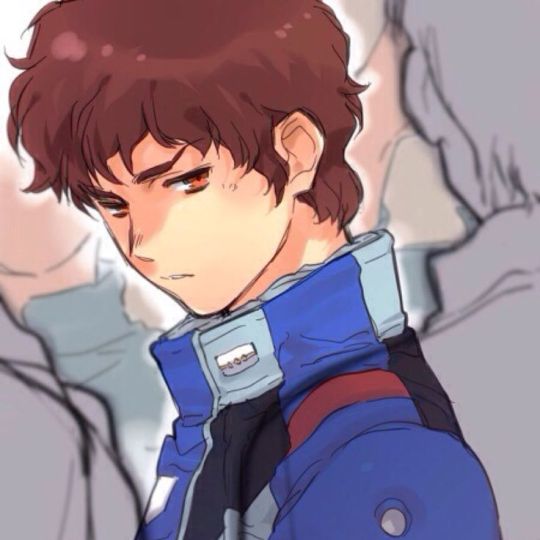

2 notes
·
View notes
Text
Last night's episode of 4 Sided Dive was absolutely wonderful in terms of the amount of insight and perspective we got. Not only the Crown Keepers interlude, but also for campaign 3's themes as a whole.
Specifically what fascinated me though, was the incredible analogy Aimee drew between the Ruidian culture and colonial influence on indigenous/colonized spaces in real life (around the 1h32m mark for reference). It was amazing question to ask and I'll love Aimee endlessly for it because it touches on am interesting parallel between the discourse surrounding the Exandiran gods and what they thematically can represent to us as an audience.
Before I dive into my thoughts, I want to preface this by saying this is my specific perspective as a queer woman of color and daughter of a refugee. While my year-5-in-a-PhD-program brain may just be over analyzing this too much, what Aimee brought up just deeply resonated with me in a way that I don't really see talked about in discussions around the themes of campaign 3. Additionally, the ideas I'll be talking about borrow heavily from Christine Taitano DeLisle's Placental Politics: CHamoru Women, White Womanhood, and Indigeneity under U.S. Colonialism in Guam (2023). Its an incredible piece on indigenous knowledge production and political action that importantly looks to decenter colonial perspectives and history (and more importantly recenter indigenous histories, knowledge, and perspectives in a way that allows us to dislodge the idea that colonialism is something that is immutable and inevitable.)
To quickly summarize Aimee's point/follow up question, she pointed out that the way Ruidians have engaged with, repurposed, and were resentful towards Exandrian cultures mirrors some of the real life experiences of colonized/marginalized communities in relation to colonialism. It was such a powerful comparison to make because in a lot of ways, the struggle of the Ruidian people over the course of the campaign along with the looming question about the gods and whether or not to save them is (intentional or not) deeply resonant with the idea of colonialism and the ways it is deeply ingrained in the even mundane aspects of our life.
In a lot of ways, the Exandrian pantheon can be seen as a colonial force. One that came in and displaced a preexisting order of things and entrenched itself in the new way of being it established. Ashton and Laudna have repeatedly pointed this out throughout the campaign. There was life and existence before the gods. The gods are merely a different mode of being, not the only and inevitable mode of being. Life, society, and being can and did exist without them.
And its important to recognize that aspect of the gods, because it helps us understand their motivations that much better. Aabria in her description of what Opal saw in the Spider Queen as she tried to take Opal as her champion was poignant. Opal did not see an omniscient, unknowable entity. She saw a woman. A woman who was frustrated, angry, and most importantly frightened. They keep Predathos chained away not to protect life on Exandria nor because they feel a moral obligation to do so. They are doing so because they are afraid. Their mortality is at stake. And, as Aabria keenly pointed out, their pride is as well. Every action, every move is out of self preservation. An attempt to save themselves because Predathos demonstrate that not even the gods are a permanent thing.
You'll find (as Anne Stoler writes about frequently) that colonial systems are much the same. They are vehemently intent on self preservation. Any action they undertake and any narrative they create about themselves is solely done to preserve the way things are currently. And that includes narratives that the way things are currently is somehow inevitable. That things were always coming to this moment. Often, this is done at the expense of framing other modes of being as somehow antithetical to the way things are now. That it needs to be this way. And that this way is right and forever.
To me, its important to recognize these parallels. While Ruidians may engage with, adapt, and innovate off of Exandrian ideas, culture, and art, it is only because - as Aimee aptly phrased it - Exandrian culture as a direct result of the gods actions has "sucked all the air out" everything. What is there to engage with, if not the looming orb in the sky that has shaped every aspect of their existence?
It really brings the campaign-wide question of "should we save the gods?" into new light, at least in my opinion. Because its suddenly not about "saving the gods in a morally righteous act to preserve all life." It becomes a layered and complicated network of issues that makes the answer to that question incredibly difficult to answer. Is preserving the status quo because its how things operate now worth it at the expense of the suffering of others? What would saving the gods and the Ruidians look like? Is it even possible to save both? What changes to how things operate would be a result of that? How would those changes be handled?
I bring this up because there is a tendency in some discourse that I've seen to frame questioning the validity of saving the gods as inherently the "wrong" choice to make. When instead, when you see the cast struggling over the question, its because the answer is not straight forward. The gods are not necessary for life. They never were. They just are necessary for life the way things are now. And the question of what disrupting that means is such a fascinating one to engage with.
#4sd#4 sided dive#critical role#cr#Bells Hells#look im probably thinking way too hard about everything#but aabria and aimee were so amazing to listen to last night#and brought in such amazing insight!!
256 notes
·
View notes
Text
I have only been here for a couple of hours and I already feel so loved, protected, and cared for.
Flight situation had its bumps, but getting switched from a window seat to a middle seat (so a family could sit together) left me with more leg room, a $100 voucher, and complimentary snack for the first leg from LAX to HNL. I had a two hour layover, had quiznos and then walked around to get my grandma the pineapple shaped shortbread cookies. Sat at the little cultural garden for a bit, taking in the scenery. Sad I couldn’t see Sarah, but maybe I’ll make time to see my other Ishizu cousins on way back once I check in with them. Second leg went by pretty fast, only annoying part was the guy sleeping on me almost the whole way. Got some reading in, watched a good portion of Minari, decent flight meal (tofu pasta, roll, chocolate covered macadamia, etc.). Getting my checked bags was easy because the first flight was so full they checked in my mini luggage, and I was one of the first people through customs.
The man asked if I was coming back home, I said yeah, after a couple years in reference to my last trip. He was so sweet and supportive, told me to move back home and run for senator lol. The other customs agent also said congrats on UCLA; felt really welcoming. Then Nina and Uncle Eric picked me up from the airport, took a picture in front of the Jamaican Grill wall mural, drove me to Scotty’s. He is so kind and so is his girlfriend, he offered for me to stay with him and use the car until his parents get back. Debating if I should, don’t want to overstay.
Read first chapter of the Chamoru diasporic routes dissertation by Jesi Lujan Bennett; pretty good. Makes me wonder how my thesis will fit into this emerging and ongoing world of Pasifika academia. Wish me luck. More updates to come.
Also spoke on the phone with my grandma, can’t wait to see her and be more intentional (and of course safe) in terms of my time with her. Also hope to see my friend Olivia before she leaves.
0 notes
Text
I hear my country in your voice
Or more like my island
Once, in class, I saw you draw a latte stone. I commented on it and saw your eyes light up. Sometimes we never expect to see ourselves in public. But we connected and ended up meeting in Guam a few months later.
I heard my island in your voice
And I ran to it as fast as possible. It has been a long time since I last swam in the ocean, so I dove right into your waters.
I heard my island in your voice
And tasted it too. You once made me beef tinaktak when we got back to the states. It was beefy and milky and green beanie, and I loved it, reminding me of my grandma. My stomach didn’t like it though, as I was a vegetarian at the time. But I didn’t mentioned it because you wanted to bring the island to us for a moment. And I missed the taste of the land.
I heard my island in your voice
You always brought the island with you. You were a weaver and shared your knowledge of the land, letting me touch and caress and move leaves around to make baskets and fans and items only found at home. I still have many of them, tucked away in Tupperwares, cared for, or even hidden. Maybe they knew what was to come.
I heard my island in your voice
And I know you heard the island in mine. To be two CHamorus navigating guiaya (love) in a land not our own. We became reflections of a place that felt multiplied when we were around each other, islands magnified, seen, held.
I continued to hear my island in your voice
Even when you stopped hearing it in mine. I saw you searching for more land, like ancient navigators, hoping for more. I saw you reach for other islands, islands bigger than me, stronger in some ways, islands that can hold you in ways that I never could.
I continued to hear my island in your voice
As I began to forget the island in mine. And I know this made you want to search more. Like a storm passing through, I felt barren, naked, until you said that you were leaving. There was another island that felt more like home, another voice that wrapped you like warm ocean breezes. So I saw you leave the island in me, saw you sail into the horizon, and didn’t turn back. Even after you left,
I continued to hear my island in your voice
In the spaces that we grew, in the dreams that we dreamt, in the community that we cared for. I continued to hear my island, see it all around me. But I couldn’t see you. Your sails were long gone, and I was left with remnants of a time. Every so often, I find pieces of the past as I walk along my shores, hoping to maybe see you in the horizon. But I know you aren’t coming back.
Sometimes I still hear my island in your voice now
When you sometimes come and visit. But keep your distance, staying outside in the reef. It makes sense though. Sometimes familiar places don’t allow us to grow. You wanted your roots to extend and grow as far as they could. But sometimes I felt like a pot of soil around you, unable to sustain even myself.
I still hear can hear your voice when I think of the islands. And I feel mahalang every time. But that is not yours to hold. I am happy that you are finding your voice, and found other islands to call home. I know that is something that you want and hope for. In this vast ocean, it is healing to know that we aren’t alone.
Now that you are gone, I want to hear the island in my voice now.
To remember where I come from. To remember the trees and the birds, and the way the worlds sounds from underneath the water. I want to remember the songs of the land, of aunties laughing, of the somber silence of a warm jungle evening….
Everyday I am beginning to hear the islands in my voice again more and more. To remember the power of the land, the kanna of the ancestors buried deep within her soil, the dreams of a future for those that come after. I hope to remember the language of coconut trees and coral reefs, of words that reflect salty ocean winds and plant medicine, to speak in genealogy and gratitude….thank you to the islands that have always been within me. I know you have always been there. Hu guiaya hao.
0 notes
Text
where is hawai'i? can you point to it on a map?

if someone asks you to point to hawai'i on a map, where would you point?
before colonization, there was (and continues to be) an island called "hawai'i". the entire chain of islands is called "hawaii" and there is a state called "hawaii" made up of a large number of those islands.
now, because there are too many things named "hawaii," the island of hawai'i is often called "the big island", because o'ahu, the island where the city of honolulu is located, is what many people think of when they think of "hawaii". it's a mess.
on top of that, we have the "main hawaiian islands" (aka "southeastern islands" aka "windward islands") vs the "outer islands" (aka "northwestern islands" aka "leeward islands").

most maps of "hawaii" show only the "main" islands. the map above (created by USGS) shows more of the hawaiian islands, but omits the names of two of the islands in the "main" chain: lana'i & kaho'olawe. these are not insignificant omissions. lana'i is 98% owned by larry ellison, founder & chairman of oracle corporation. kaho'olawe has been relentlessly used & abused by the west. it has been used for ranchland, military training, and most notably, as a munitions testing site, resulting in the continued contamination of the island. after many years of protests & lawsuits by native hawaiians, the island is now only accessible by native hawaiians for cultural, spiritual, & subsistence reasons.
meanwhile, this tourist mug with a creepy colonial-style map of hawaii includes both kaho'olawe & lana'i. good job, tourist mug!
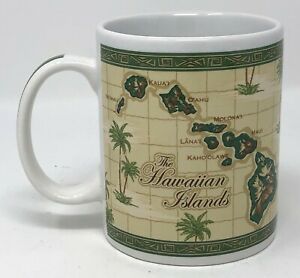
there are actually over a hundred islands in the hawaiian archipelago. the state of hawaii includes 137 of them (source). midway atoll (made up of 3 islands) is part of the archipelago, but not part of the state. it is one of america's territories: an unorganized unincorporated territory.
additionally, some of the islands "are too small to appear on maps, and others, such as Maro Reef, only appear above the water's surface during times of low tide. Others, such as Shark and Skate islands, have completely eroded away." [source: wikipedia page "list of islands of hawaii"].
in the course of writing this post, i failed to find a map that shows & names all the hawaiian islands and failed to even find a list of all of them (plus if an island only appears sometimes or has disappeared entirely, what do you even do with that?). if you find either or both of those, let me know in comments.
so where and what "hawaii" is remains a mystery.
but this has not prevented commercial & official interests from using maps of "hawaii" in all kinds of places! here on the islands, hawaii map imagery is all around.
maps are very common on tourist items:

the hawaiian telcom logo uses dots roughly arranged in the pattern of the islands on a map:

but i guess only five islands are worth including (i understand. branding needs come above all else!).
this souvenir cloth item is interesting because it includes all the main islands (including ni'ihau, lana'i, and kaho'olawe - which are often excluded), but smooshes them into the available space without much consideration for where they are in relation to each other:

the postcard above has the main islands in their rough places, but squishes them all together so that they fit in the space. also the islands are made more similar in size to each other so that you can better see the little illustrations.
here's a more "official" map to show where the islands "should be" in relation to each other, and their sizes relative to each other (although both of those can change depending on what projection the map uses):

in my mind, though, the ultimate hawaii map fantasy lives on the ubiquitous reusable walmart cloth bag (available for 50 cents at checkout to all who have forgotten to bring the right number of bags. there's a plastic shopping bag ban in hawaii.):

in the walmart commercial universe (wcu), the only islands that exist are islands that have a walmart. the general outlines of the islands & their general orientation is preserved (along with a rough topology too!), attempting to convey a sense of adhering to a recognizable reality, but islands without a walmart have been not only omitted, but the space where they would be has been eliminated as well - as if they were never there to begin with. in the walmart version of reality, what makes something "hawaii" is whether or not it has a walmart on it.
i've had a lot of time to think about this remarkable image because i have a whole bunch of these bags. this is the bag of the people - everyone uses it for everything. the one in the above photo is in a typical state - pretty rough - because it probably came from the side of the road. you can almost always find one on the side of the road. so wherever you are, you are probably within sight of the walmart version of the islands.
so why does it matter whether or not you can point to "hawaii" on a map? well, maps are political documents, meaning that they reflect the vision of whoever has the power to put the map in front of your eyes. so if you're the one with the power to make some of the most commonly-seen maps of hawaii and you decide to remove a few islands, well that can really shape what people think "hawaii" is! we're a sea of islands - many people here have only ever been to one or two of the islands. if it wasn't on the map, you might not know that it existed at all.
hawaii is incredibly important to the united states, not just for tourism, but in terms of global strategy. it's the largest outpost of american power in the middle of the pacific. it puts america & its troops half an ocean closer to some of america's biggest competitors, most notably, china. it's a springboard to all the other island territories of the pacific (which you maybe haven't heard of because they almost never appear on maps):

once you see a map of all of america's territories in the pacific, along with the exclusive economic zones (eez) that extend out for 200 miles around each island, you start to get a better feel for the extent of america's power in the pacific.
when a place is left off the map, it can be easy to make it (including its people!) invisible. so if you're america, with bases across the islands of the pacific, with a nightmarish history of atomic weapons testing in the pacific (rendering islands uninhabitable and leaving both land and waters too contaminated for people to use), perhaps you might not want some of these places to appear on the map.
in Foreign Policy in Focus, Khury Petersen-Smith writes:
"Many of us living in North America who are concerned about climate change, for example, have a sense that Pacific Islands are facing particularly severe impacts from rising sea levels. But that knowledge tends to be vague and limited, as actual residents of these islands are rarely invited to the table to speak for themselves.
This is not accidental. Commenting during the Nixon administration on U.S. nuclear testing in the Marshall Islands, which share the same region of the Pacific as Guam, Henry Kissinger said “there are only 90,000 people out there. Who gives a damn?”
The U.S. has long had an interest in Marshallese and other Pacific Islanders remaining “out there” in the American mind. This marginalization helps allow the U.S. to carry out military operations in the region, along with policies that further climate change and other harms, while keeping most Americans unaware of these practices’ impacts in the Pacific." [FPIF]
often hawai'i (and alaska - which is in many ways similar to hawai'i in its relation to the contiguous US) doesn't even appear on national maps of the USA.
here's a screenshot from the new york times homepage on march 21, 2020, just as the coronavirus pandemic was beginning to spread:

there is no alaska and no hawai'i on those maps. so if you were looking for information on the most important issue that was happening at the time, and you live in or are concerned about hawai'i and/or alaska, there would just be nothing. and what does it say about the people who run the top newspaper in america that they decided it was fine to omit these two states? are they not states? do they not matter? do the readers in those states not matter? and this is not an unusual thing at all. it happens all the time.
i'd like to finish by sharing with you a poem by CHamoru poet Craig Santos Perez. CHamoru are the indigenous people of the mariana islands (which include guam, saipan, tinian, rota, and others).
in this poem, Craig Santos Perez writes about not appearing on the map...
“Off-Island CHamorus”
My family migrated to California when I was 15 years old.
During the first day at my new high school, the homeroom
teacher asked: “Where are you from?” “The Mariana Islands,”
I answered. He replied: “I’ve never heard of that place.
Prove it exists.” And when I stepped in front of the world map
on the wall, it transformed into a mirror: the Pacific Ocean,
like my body, was split in two and flayed to the margins. I
found Australia, then the Philippines, then Japan. I pointed
to an empty space between them and said: “I’m from this
invisible archipelago.” Everyone laughed. And even though
I descend from oceanic navigators, I felt so lost, shipwrecked
on the coast of a strange continent. “Are you a citizen?”
he probed. “Yes. My island, Guam, is a U.S. territory.”
We attend American schools, eat American food, listen
to American music, watch American movies and television,
play American sports, learn American history, dream
American dreams, and die in American wars. “You
speak English well,” he proclaimed, “with almost no
accent.” And isn’t that what it means to be a diasporic
CHamoru: to feel foreign in a domestic sense.
Over the last 50 years, CHamorus have migrated to
escape the violent memories of war; to seek jobs, schools
hospitals, adventure, and love; but most of all, we’ve migrated
for military service, deployed and stationed to bases around
the world. According to the 2010 census, 44,000 CHamorus
live in California, 15,000 in Washington, 10,000 in Texas,
7,000 in Hawaii, and 70,000 more in every other state
and even in Puerto Rico. We are the most “geographically
dispersed” Pacific Islander population within the United
States, and off-island CHamorus now outnumber
our on-island kin, with generations having been born
away from our ancestral homelands, including my daughters.
Some of us will be able to return home for holidays, weddings,
and funerals; others won’t be able to afford the expensive plane
ticket to the Western Pacific. Years and even decades might pass
between trips, and each visit will feel too short. We’ll lose contact
with family and friends, and the island will continue to change
until it becomes unfamiliar to us. And isn’t that, too, what it means
to be a diasporic CHamoru: to feel foreign in your own homeland.
Even after 25 years, there are still times I feel adrift, without
itinerary or destination. When I wonder: What if we stayed? What if
we return? When the undertow of these questions begins pulling
you out to sea, remember: migration flows through our blood
like the aerial roots of the banyan tree. Remember: our ancestors
taught us how to carry our culture in the canoes of our bodies.
Remember: our people, scattered like stars, form new constellations
when we gather. Remember: home is not simply a house,
village, or island; home is an archipelago of belonging.
–Craig Santos Perez
----------
thank you for reading this post! please let me know if you see any errors.
if you'd like to learn more about some important issues in the pacific, here are just a few:
july 2, 2020: "US says leaking nuclear waste dome is safe; Marshall Islands leaders don't believe it" - Los Angeles Times
may 30, 2021: "Pacific Plunder: this is who profits from the mass extraction of the region's natural resources." - The Guardian
april 5, 2021: "75 years after nuclear testing in the Pacific began, the fallout continues to wreak havoc" - The Conversation
june 4, 2021: "Guam won’t give up more land to the U.S. military without a fight" - The World (radio program)
aug. 24, 2021: "The US is building a military base in the middle of the Pacific Ocean. Micronesian residents have questions." - The World (radio program)
and if you'd like to learn more about how maps are political, here are a couple articles:
june 5, 2014: "The politics of making maps" by Amanda Ruggeri, for BBC
july 11, 2018: "Politics and Cartography: The Power of Deception through Distortion" by John Erskine, for the Carnegie Ethics Online Monthly Column
22 notes
·
View notes
Photo
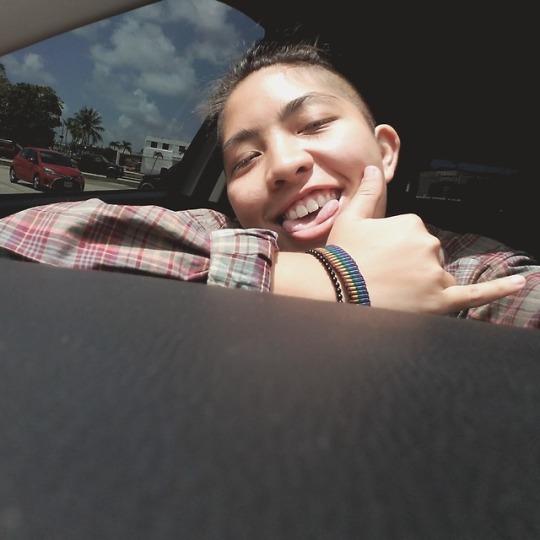
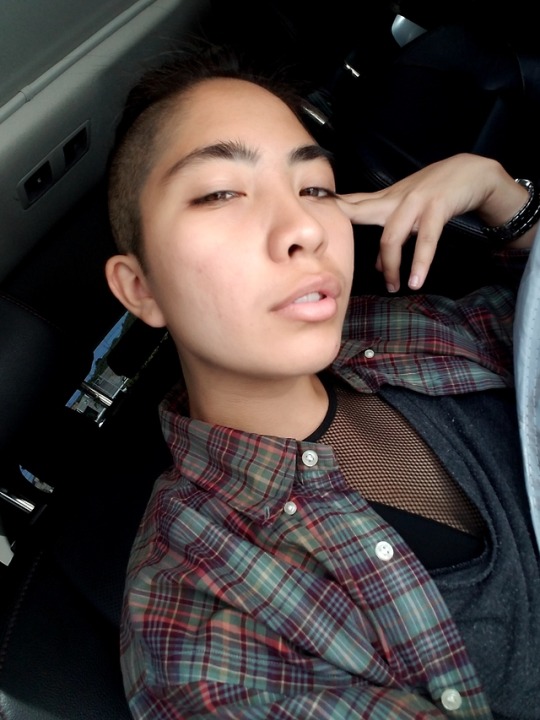
Queer | CHamoru-Filipnx | they • them • theirs
Sometimes it can be difficult to either participate or not participate in this gay ass time due to various circumstances outside of our control but i hope you all can still celebrate in any way you can 💗 some suggestions to follow:
☆ wear rainbows or your flag colors or glitter or anything that makes you feel comfortable in your own skin
☆ work towards being more sex, queer, and trans positive in your day to day interactions
☆ masturbate to/with your local queer
☆ punch a homophobe/transphobe/terf in the face
☆ or all of the above if you really want to turn me on ;)
HAPPY PRIDE ! 🌈✨
PS: I’m queer 24/7 , 365 therefore so are Pride posts. Your identities are not limited to this weekend nor the month of June - love on your love year round ❤
50 notes
·
View notes
Text
The Climate Crisis Isn’t Just Taking Pacific Islanders’ Homes, It’s Taking Our Identities
According to traditional knowledge, in Southeast Asia at the end of the last Ice Age, “fenua imi,” the swallowing of land, forced people to relocate to faraway atolls in a region now called Oceania. About 4,500 years of global stability allowed for the island cultures to develop and thrive in ways specifically tied to the local environment.
Now fenua imi has returned.
Guam, my ancestral land, is one of 38 nations and territories in the Pacific Islands, including Kiribati, West Papua, Fiji, and New Caledonia, where Pasifika people like me have lived for thousands of years. In recent history, our homeland has been divided, colonized, and used as a pawn in U.S. war efforts. Guam’s geographic position and natural deepwater port, Apra Harbor, make it one of the U.S. military’s most strategic bases around the world, so military land seizures have remained constant since World War II.
"Fenua imi," the swallowing of land, has returned to Guam. Drone footage by Lynn Englum, Vanishing Places
It now faces near unlivable conditions because of the climate crisis: Dead arms of staghorn coral are beached; typhoons and super typhoons sweep through more regularly, building on Guam’s position in the most active storm basin in the world; drinking water reservoirs already contaminated with military runoff are becoming depleted as the dry season gets drier. Our subsistence way of life is threatened by nuclear wastewater spills, shifting fishing cycles, and salinated land. Since 1993, sea level surrounding Guam has risen 4 inches and is expected to rise by 3 feet in the next century. Low-lying islands throughout the Pacific could become uninhabitable by 2050.

Super storms sweep through the area more regularly. Photo courtesy of Raimon Kataotao/Humans of Kiribati
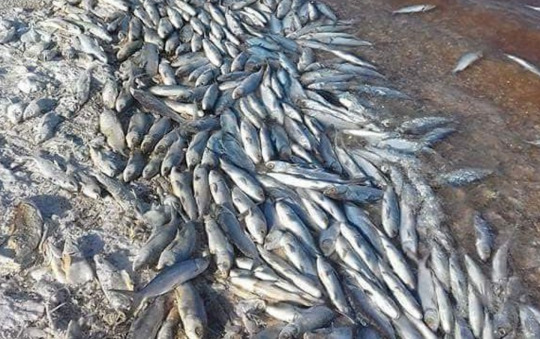
Lack of rain and extreme heat have caused some ponds to dry up or have increased the salinity of the water, killing hundreds of milkfish. Photo courtesy of RADIO KIRIBATI News/Humans of Kiribati
But the loss of these islands, atolls, and archipelagos is more than just loss of land: it’s a threat to the political and cultural future of Pasifika communities. It’s why, even in the face of rising seas, the loss of tillable land, pesticide pollution, and a simulated war zone, the island feels impossible to leave.
Already, island nations throughout the Pacific are preparing to leave their homes. In 2014 then Kiribati president Anote Tong purchased a large section of land on an island in Fiji for citizens forced to relocate because of the climate crisis.
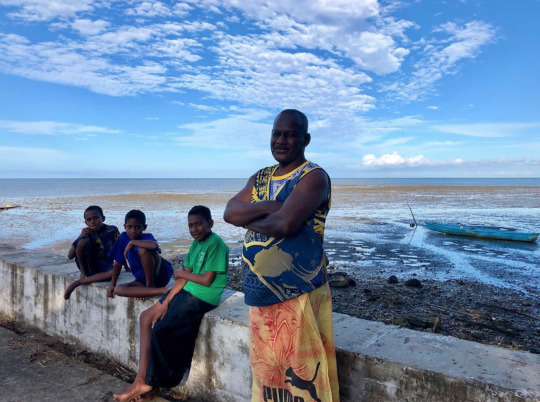
During Cyclone Winston in 2016 water went over the seawall and flooded Kumi Village in Fiji, wiping out homes and making the rainwater catch undrinkable. “My fear is that the sea will come in and these sea walls won’t last,” said Kumi Village headman Timoci Ravasakula. “It’s important to be close to the ocean. Our village has always been close to it and we want to continue this.” Photo by Lynn Englum/Vanishing Places
This migration represents a cultural loss. The land our creators made for us, the land that our ancestors are buried in, is disappearing underwater with more and more centimetres of land slipping away every year. Five of the Solomon Islands have been lost since the mid-20th century, and sea level around Palau is rising at a rate three times the global average.
Tong has created a program to “migrate with dignity,” providing Kiribati citizens with tools to relocate legally and find work in an effort to protect their human rights before they become, as they are called colloquially, climate refugees. Citizens of Kiribati “would not be people running away from something,” Tong told VICE News. “They would be migrating, relocating as people with skills as members of communities they go into, even leaders, I hope.”
More and more centimetres of land are slipping away every year. Drone footage of Tarawa, Kiribati by Lynn Englum/Vanishing Places
The United States first occupied Guam at the turn of the 20th century as a result of the Spanish-American War. Besides a brief period during World War II when the island was occupied by Japan, the United States has maintained possession of the territory. By 1950 the CHamoru people, Guam’s native inhabitants, became a minority as the population of the island skyrocketed to nearly one-third United States-born after Guam was used as a forward base for U.S. attacks targeting Japan during World War II.
The military seized 82 percent of the land for military purposes. Gravesites and traditional medicine, thousand-year-old artifacts, and remnants of our family members were parcelled and razed. Those liberated from concentration camps, like my grandmother, were pushed into refugee camps. The land filled with Agent Orange, nuclear waste, and artillery shells. Our ecological future was placed in the hands of the U.S. military, one of the world’s largest global polluters.
Now, a third of Guam is home to military installations. Much of the coverage of climate change on the island has focused on how those changes will damage the bases.
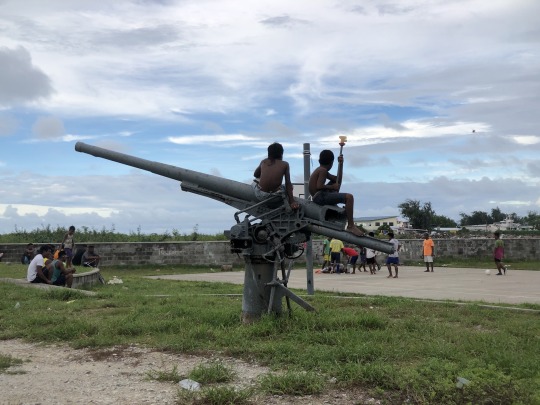
Kiribati like much of Micronesia was part of the WWII Pacific Ocean theatre. Photo by Lynn Englum, Vanishing Places
While vying for environmental protections, the actual nationhood of Pacific Island states is also caught within an international fight for recognition. Guam is one of 17 non-self-governing territories recognized by the United Nations, but it’s in the middle of a plebiscite concerning the island’s status in relation to the United States.
Today, living in Guam can mean that live-fire artillery is one of the first noises a child can expect to hear, even from the womb. It can mean that our elders die at young ages and our aunties and uncles struggle with the illnesses that come from the fallout of nuclear testing. It can mean undrinkable water thanks to the runoff from the Air Force base above the aquifer.

A ship that washed ashore in Tarawa during Cyclone Pam in 2015, surrounded by sandbags in August as residents prepared for the highest tide this year. Photo courtesy of Humans of Kiribati
But leaving Guam means saying goodbye to the only home most of my family has ever known. Leaving Guam, in managed retreat or otherwise, can feel like admitting defeat in a 500-year fight for self-determination.
I moved to Washington D.C. this year to work on supporting Indigenous resistance movements while combating the climate crisis. I tell myself that living away from Guam—and outside the Pacific entirely—is a sacrifice I made to ensure there’s a safe environment to return to. But, I question that belief. Diaspora islanders like myself can grow up watching the rest of our family become strangers in our island with the influx of service members, while growing more isolated from those of us who have left for higher land.
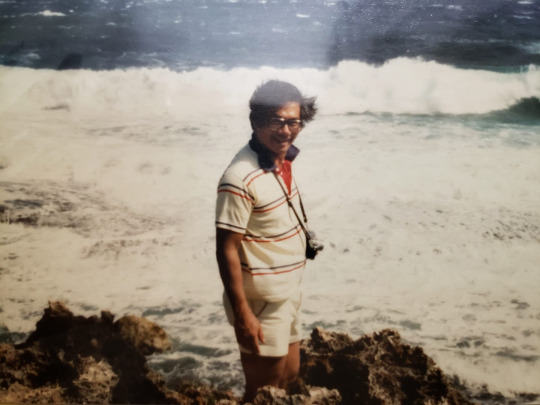
Leilani Rania Ganser’s grandfather on Guam, 1978. Photo provided by author
War and the military incursions exacerbate the climate crisis, and the climate crisis worsens our humanitarian needs. This destructive cycle also regulates the immigration of soldiers to island bases in Micronesia, which itself has accelerated the environmental degradation of land Indigenous Pasifika have relied on for centuries for sustenance. This degradation then pushes Pasifika out of our islands and works to silence the sovereignty movements grounded in our ecologically minded cultures.
This makes managed retreat a question of Indigenous sovereignty or, put another way, makes Indigenous sovereignty a form of climate action. It underscores the necessity of listening to the Indigenous population of a region of the climate crisis and gives context to the global challenges Indigenous climate defenders face.
Leilani Rania Ganser is a Kānaka Maoli and CHamoru writer, activist, and survivor. Her bylines appear in In These Times, Foreign Policy In Focus, Korean Policy Institute, and more. Follow her on Twitter.
Humans of Kiribati shares stories about Kiribati and the people living on the front lines of the climate crisis. Like them on Facebook.
Lynn Englum has been writing on climate change and resilience issues for more than a decade. For the past year, she’s been travelling to places deeply affected by climate change. Follow her journey on Instagram.
Have a story for Tipping Point? Email [email protected]
The Climate Crisis Isn’t Just Taking Pacific Islanders’ Homes, It’s Taking Our Identities syndicated from https://triviaqaweb.wordpress.com/feed/
0 notes
Text
Hi dad,
I am here, where you used to work. In the produce area, next to empty shelves of bananas and oranges. If you were here, I doubt these would be empty. I heard that you coworkers loved you, and the way you worked. I don’t see anyone right now, and I think this is the first time I had been here since you worked here - I know, I had some feelings towards you which prevented me from connecting with you.
Like anger, and frustration and hope. I think that is why I held onto to this relationship for so long, because he reminded me of you. And I longed for a connection with you, even if it didn’t seem like it. To be held and loved by you, to be seen and understood - I think that is why I held on. He did some of that, until he stopped, yet I held on, because it was all I had to you in some way. To a CHamoru guy with so much passion, creativity….in a lot of ways, I wanted to be like you, to be courageous and grounded in myself. But even today, I find that I am still a bit scared and unsure, but I am getting better.
Like, I am going on this residency pretty soon. It will be in the woods and I get to do some ceramics. Or pottery. I always wanted to try that, and I hope that it turns out. Like i would love to make plates and bowls and homeward goods for people to use. Inspired by the land and sea, inspired by the place that we grew up in. I hope that you can be there when I try it, because I know I might get impatient and lost, but I hope you are proud of me for trying something new.
Ok I think imma go now. I am a bit hungry and was crying a bit here in Safeway, so maybe I need to take a walk. Glad to have these masks though to hide these tears. But I hope you are doing well and having fun up there with everyone. Take care, roldy. 😀
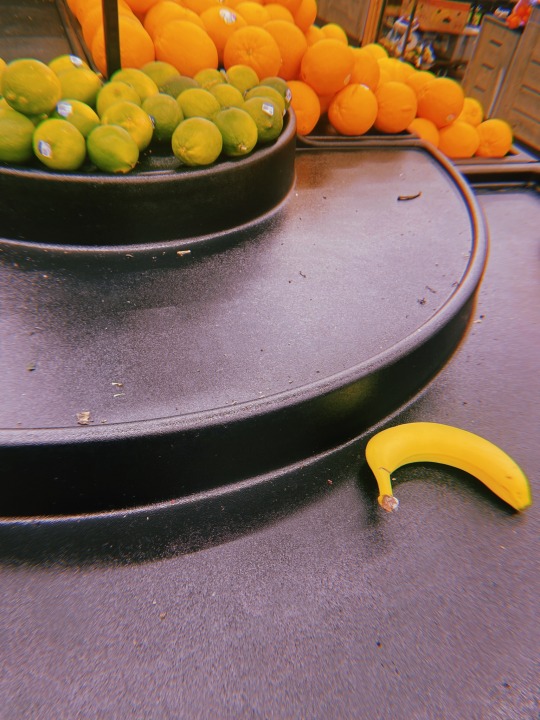
0 notes